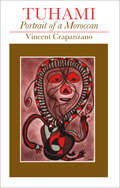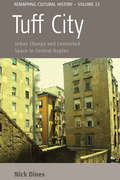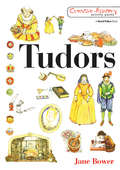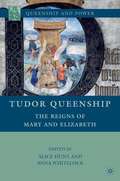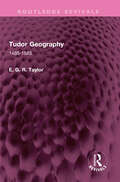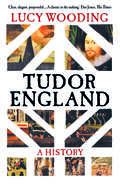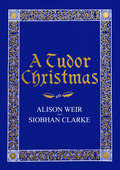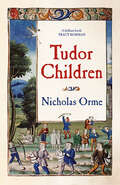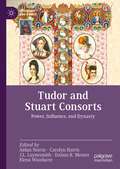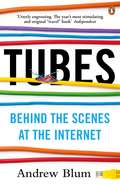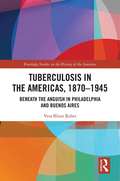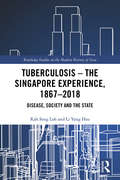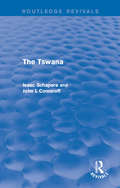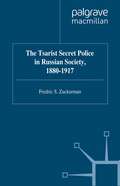- Table View
- List View
Tuhami: Portrait of a Moroccan
by Vincent CrapanzanoTuhami is an illiterate Moroccan tilemaker who believes himself married to a camel-footed she-demon. A master of magic and a superb story-teller, Tuhami lives in a dank, windowless hovel near the kiln where he works. Nightly he suffers visitations from the demons and saints who haunt his life, and he seeks, with crippling ambivalence, liberation from 'A'isha Qandisha, the she-demon. In a sensitive and bold experiment in interpretive ethnography, Crapanzano presents Tuhami's bizarre account of himself and his world. In so doing, Crapanzano draws on phenomenology, psychoanalysis, and symbolism to reflect upon the nature of reality and truth and to probe the limits of anthropology itself. Tuhami has become one of the most important and widely cited representatives of a new understanding of the whole discipline of anthropology.
Tuhami: Portrait of a Moroccan
by Vincent CrapanzanoTuhami is an illiterate Moroccan tilemaker who believes himself married to a camel-footed she-demon. A master of magic and a superb story-teller, Tuhami lives in a dank, windowless hovel near the kiln where he works. Nightly he suffers visitations from the demons and saints who haunt his life, and he seeks, with crippling ambivalence, liberation from 'A'isha Qandisha, the she-demon. In a sensitive and bold experiment in interpretive ethnography, Crapanzano presents Tuhami's bizarre account of himself and his world. In so doing, Crapanzano draws on phenomenology, psychoanalysis, and symbolism to reflect upon the nature of reality and truth and to probe the limits of anthropology itself. Tuhami has become one of the most important and widely cited representatives of a new understanding of the whole discipline of anthropology.
Tuhami: Portrait of a Moroccan
by Vincent CrapanzanoTuhami is an illiterate Moroccan tilemaker who believes himself married to a camel-footed she-demon. A master of magic and a superb story-teller, Tuhami lives in a dank, windowless hovel near the kiln where he works. Nightly he suffers visitations from the demons and saints who haunt his life, and he seeks, with crippling ambivalence, liberation from 'A'isha Qandisha, the she-demon. In a sensitive and bold experiment in interpretive ethnography, Crapanzano presents Tuhami's bizarre account of himself and his world. In so doing, Crapanzano draws on phenomenology, psychoanalysis, and symbolism to reflect upon the nature of reality and truth and to probe the limits of anthropology itself. Tuhami has become one of the most important and widely cited representatives of a new understanding of the whole discipline of anthropology.
Tuhami: Portrait of a Moroccan
by Vincent CrapanzanoTuhami is an illiterate Moroccan tilemaker who believes himself married to a camel-footed she-demon. A master of magic and a superb story-teller, Tuhami lives in a dank, windowless hovel near the kiln where he works. Nightly he suffers visitations from the demons and saints who haunt his life, and he seeks, with crippling ambivalence, liberation from 'A'isha Qandisha, the she-demon. In a sensitive and bold experiment in interpretive ethnography, Crapanzano presents Tuhami's bizarre account of himself and his world. In so doing, Crapanzano draws on phenomenology, psychoanalysis, and symbolism to reflect upon the nature of reality and truth and to probe the limits of anthropology itself. Tuhami has become one of the most important and widely cited representatives of a new understanding of the whole discipline of anthropology.
Tuff City: Urban Change and Contested Space in Central Naples (Remapping Cultural History #13)
by Nick DinesDuring the 1990s, Naples’ left-wing administration sought to tackle the city’s infamous reputation of being poor, crime-ridden, chaotic and dirty by reclaiming the city’s cultural and architectural heritage. This book examines the conflicts surrounding the reimaging and reordering of the city’s historic centre through detailed case studies of two piazzas and a centro sociale, focusing on a series of issues that include heritage, decorum, security, pedestrianization, tourism, immigration and new forms of urban protest. This monograph is the first in-depth study of the complex transformations of one of Europe’s most fascinating and misunderstood cities. It represents a new critical approach to the questions of public space, citizenship and urban regeneration as well as a broader methodological critique of how we write about contemporary cities.
Tudors
by Jane BowerThe innovative Creative History Activity Packs series is designed to help teachers bring history topics to life through imaginative creative arts activities. Each pack includes ten laminated, double-sided cards, printed in full color. Each card describes in detail activities that recreate aspects of life in a particular historical period, using art, drama and dance. Each activity is based on historically researched authentic practices of the time. Ideal for whole class or small group sessions, the packs are an inspiration for busy teachers looking for new ways to approach project work at Key Stage 2 - and are easily applicable for Key Stage 1 classes. Tudor activities in this pack include creating clove pomanders and soap balls; painting miniatures to mount as jewelry; making your own ink and writing a Tudor menu; making a miniature book for herbs, recipes or prayers; Tudor recipe ideas; and structured outlines for drama and dance.
Tudors
by Jane BowerThe innovative Creative History Activity Packs series is designed to help teachers bring history topics to life through imaginative creative arts activities. Each pack includes ten laminated, double-sided cards, printed in full color. Each card describes in detail activities that recreate aspects of life in a particular historical period, using art, drama and dance. Each activity is based on historically researched authentic practices of the time. Ideal for whole class or small group sessions, the packs are an inspiration for busy teachers looking for new ways to approach project work at Key Stage 2 - and are easily applicable for Key Stage 1 classes. Tudor activities in this pack include creating clove pomanders and soap balls; painting miniatures to mount as jewelry; making your own ink and writing a Tudor menu; making a miniature book for herbs, recipes or prayers; Tudor recipe ideas; and structured outlines for drama and dance.
Tudor Queenship: The Reigns of Mary and Elizabeth (Queenship and Power)
by Alice Hunt & Anna WhitelockThis book brings together a selection of recent, cutting-edge research which, for the first time, challenges commonplace arguments about Mary and Elizabeth's relative successes or failures in order to rethink Tudor queenship.
Tudor Geography: 1485-1583 (Routledge Revivals)
by E. G. TaylorFirst published in 1930, Tudor Geography discusses the men and the geographical concepts that enabled world-famous voyages by the British with the aim of circumventing Spanish and Portuguese monopoly of the direct routes to the Spice Islands. The book throws light on a new facet of a fateful century during which Englishmen of all ranks were forced gradually, by circumstances, to think geographically as they had never done before. This book will be of interest to students of history and geography.
Tudor Geography: 1485-1583 (Routledge Revivals)
by E. G. TaylorFirst published in 1930, Tudor Geography discusses the men and the geographical concepts that enabled world-famous voyages by the British with the aim of circumventing Spanish and Portuguese monopoly of the direct routes to the Spice Islands. The book throws light on a new facet of a fateful century during which Englishmen of all ranks were forced gradually, by circumstances, to think geographically as they had never done before. This book will be of interest to students of history and geography.
Tudor England: A History
by Lucy WoodingA compelling, authoritative account of the brilliant, conflicted, visionary world of Tudor England When Henry VII landed in a secluded bay in a far corner of Wales, it seemed inconceivable that this outsider could ever be king of England. Yet he and his descendants became some of England’s most unforgettable rulers, and gave their name to an age. The story of the Tudor monarchs is as astounding as it was unexpected, but it was not the only one unfolding between 1485 and 1603. In cities, towns, and villages, families and communities lived their lives through times of great upheaval. In this comprehensive new history, Lucy Wooding lets their voices speak, exploring not just how monarchs ruled but also how men and women thought, wrote, lived, and died. We see a monarchy under strain, religion in crisis, a population contending with war, rebellion, plague, and poverty. Remarkable in its range and depth, Tudor England explores the many tensions of these turbulent years and presents a markedly different picture from the one we thought we knew.
A Tudor Christmas
by Alison Weir Siobhan ClarkeChristmas in Tudor times was a period of feasting, revelry and merrymaking ‘to drive the cold winter away’. A carnival atmosphere presided at court, with a twelve-day-long festival of entertainments, pageants, theatre productions and ‘disguisings’, when even the king and queen dressed up in costume to fool their courtiers. Throughout the festive season, all ranks of subjects were freed for a short time from everyday cares to indulge in eating, drinking, dancing and game-playing.We might assume that our modern Christmas owes much to the Victorians. In fact, as Alison Weir and Siobhan Clarke reveal in this fascinating book, many of our favourite Christmas traditions date back much further. Carol-singing, present-giving, mulled wine and mince pies were all just as popular in Tudor times, and even Father Christmas and roast turkey dinners have their origins in this period. The festival was so beloved by English people that Christmas traditions survived remarkably unchanged in this age of tumultuous religious upheaval.Beautifully illustrated with original line drawings throughout, this enchanting compendium will fascinate anyone with an interest in Tudor life – and anyone who loves Christmas.
Tudor Children
by Nicholas OrmeThe first history of childhood in Tudor England What was it like to grow up in England under the Tudors? How were children cared for, what did they play with, and what dangers did they face? In this beautifully illustrated and characteristically lively account, leading historian Nicholas Orme provides a rich survey of childhood in the period. Beginning with birth and infancy, he explores all aspects of children’s experiences, including the games they played, such as Blind Man’s Bluff and Mumble-the-Peg, and the songs they sang, such as “Three Blind Mice” and “Jack Boy, Ho Boy.” He shows how social status determined everything from the food children ate and the clothes they wore to the education they received and the work they undertook. Although childhood and adolescence could be challenging and even hazardous, it was also, as Nicholas Orme shows, a treasured time of learning and development. By looking at the lives of Tudor children we can gain a richer understanding of the era as a whole.
Tudor and Stuart Consorts: Power, Influence, and Dynasty (Queenship and Power)
by Aidan Norrie Carolyn Harris J. L. Laynesmith Danna R. Messer Elena WoodacreThis book examines the lives and tenures of all the consorts of the Tudor and Stuart monarchs of England between 1485 and 1714, as well as the wives of the two Lords Protector during the Commonwealth. The figures in Tudor and Stuart Consorts are both incredibly familiar—especially the six wives of Henry VIII—and exceedingly unfamiliar, such as George of Denmark, the husband of Queen Anne. These innovative and authoritative biographies recognise the important role consorts played in a period before constitutional monarchy: in addition to correcting popular assumptions that are based on limited historical evidence, the chapters provide a fuller picture of the role of consort that goes beyond discussions of exceptionalism and subversion. This volume and its companions reveal the changing nature of English consortship from the Norman Conquest to today.
Tubes: Behind the Scenes at the Internet
by Andrew BlumThe Internet. Home to the most important and intimate aspects of our lives. Our careers, our relationships, our selves, all of them are out there - online. So ... where is that exactly? And who's in charge again? And what if it breaks?In Tubes Andrew Blum takes us on a gripping backstage tour of the real but hidden world of the Internet, introducing us to the remarkable clan of insiders and eccentrics who own, design and run it everyday. He uncovers the secret data warehouses where our online selves are stored, peels back the wires that transport us across the globe, reveals its mammoth hubs and surprising alley-ways, explaining what the Internet actually is, where it is, how it got there - and, yes, what happens when it breaks.
Tuberculosis in the Americas, 1870-1945: Beneath the Anguish in Philadelphia and Buenos Aires
by Vera Blinn ReberThis book focuses on the era during which the cause of tuberculosis had been identified, and public health officials were seeking to prevent it, but scientists had not yet found a cure. By examining tuberculosis comparatively in two Atlantic port cities, Buenos Aires and Philadelphia, it explores the medical, political and economic settings in which patients, physicians and urban officials lived and worked. Reber discusses the causes of tuberculosis, treatments and public health efforts to stop contagion, and how factors such as gender, age, class, nationality, beliefs and previous experiences shaped patient responses, and often defined the type of treatment.
Tuberculosis in the Americas, 1870-1945: Beneath the Anguish in Philadelphia and Buenos Aires
by Vera Blinn ReberThis book focuses on the era during which the cause of tuberculosis had been identified, and public health officials were seeking to prevent it, but scientists had not yet found a cure. By examining tuberculosis comparatively in two Atlantic port cities, Buenos Aires and Philadelphia, it explores the medical, political and economic settings in which patients, physicians and urban officials lived and worked. Reber discusses the causes of tuberculosis, treatments and public health efforts to stop contagion, and how factors such as gender, age, class, nationality, beliefs and previous experiences shaped patient responses, and often defined the type of treatment.
Tuberculosis – The Singapore Experience, 1867–2018: Disease, Society and the State (Routledge Studies in the Modern History of Asia)
by Kah Seng Loh Li Yang HsuThrough a rich account of tuberculosis in Singapore from the mid-nineteenth century to the present day, this book charts the relationship between disease, society and the state, outlining the struggles of colonial and post-colonial governments to cope with widespread disease and to establish effective public health programmes and institutions. Beginning in the nineteenth century when British colonial administrators viewed tuberculosis as a racial problem linked to the poverty, housing and insanitary habits of the Chinese working class, the book goes on to examine the ambitious medical and urban improvement initiatives of the returning British colonial government after the Second World War. It then considers the continuation and growth of these schemes in the post-colonial period and explores the most recent developments which include combating the resurgence of TB and the rise of antimicrobial resistance.
Tuberculosis – The Singapore Experience, 1867–2018: Disease, Society and the State (Routledge Studies in the Modern History of Asia)
by Kah Seng Loh Li Yang HsuThrough a rich account of tuberculosis in Singapore from the mid-nineteenth century to the present day, this book charts the relationship between disease, society and the state, outlining the struggles of colonial and post-colonial governments to cope with widespread disease and to establish effective public health programmes and institutions. Beginning in the nineteenth century when British colonial administrators viewed tuberculosis as a racial problem linked to the poverty, housing and insanitary habits of the Chinese working class, the book goes on to examine the ambitious medical and urban improvement initiatives of the returning British colonial government after the Second World War. It then considers the continuation and growth of these schemes in the post-colonial period and explores the most recent developments which include combating the resurgence of TB and the rise of antimicrobial resistance.
The Tswana (Routledge Revivals)
by Isaac Schapera John L ComaroffFirst published in 1953 and this edition in 1991, this book was created in association with the International African Institute. Since its first publication, anthropology and African Studies have changed a great deal, but the bedrock of both remains unchanged: solid, sensitive ethnographic and historical accounts of the peoples and cultures of the continent. Part One is by Isaac Schapera whose documentation of life and times in the Bechuanaland Protectorate stands as a starkly detailed chronical of an African population in a rapidly changing world. Schapera was one of the few anthropologists who spoke frankly of the rural predicament of rural Africans under colonialism. Far from describing the Tswana as a closed or timeless ‘society’, he locates the people in their political and economic context, and in so doing, has left behind an extraordinary record. This edition of The Tswana consists of the original text to which has been added a second part by John L. Comaroff, which covers the transformation of Tswana life in Botswana and South Africa 1953-85, plus a much enlarged bibliography. Together, the parts of the book make a valuable summary of an exceedingly rich and ethnographic and historical record that will continue to serve as an indispensable tool in research and teaching.
The Tswana: Compiled For The Bechuanaland Protectorate Administration Classics In African Anthropology (Routledge Revivals #72)
by Isaac Schapera John L ComaroffFirst published in 1953 and this edition in 1991, this book was created in association with the International African Institute. Since its first publication, anthropology and African Studies have changed a great deal, but the bedrock of both remains unchanged: solid, sensitive ethnographic and historical accounts of the peoples and cultures of the continent. Part One is by Isaac Schapera whose documentation of life and times in the Bechuanaland Protectorate stands as a starkly detailed chronical of an African population in a rapidly changing world. Schapera was one of the few anthropologists who spoke frankly of the rural predicament of rural Africans under colonialism. Far from describing the Tswana as a closed or timeless ‘society’, he locates the people in their political and economic context, and in so doing, has left behind an extraordinary record. This edition of The Tswana consists of the original text to which has been added a second part by John L. Comaroff, which covers the transformation of Tswana life in Botswana and South Africa 1953-85, plus a much enlarged bibliography. Together, the parts of the book make a valuable summary of an exceedingly rich and ethnographic and historical record that will continue to serve as an indispensable tool in research and teaching.
The Tsarist Secret Police in Russian Society, 1880-1917 (Studies in Russia and East Europe)
by F. ZuckermanThis is the first book to portray the history of the Russian secret police - the so-called 'Okhrana' - its personnel, world view and interaction with both government and people during the reigns of Alexander III and Nicholas II. The secret police harassed, infiltrated and subverted Russian radical and progressive society as it struggled to preserve Tsardom's traditional political culture in the face of Russia's rapid socio-economic transformation - a transformation which the forces of order scarcely understood, yet deeply despised.
Ts'ao P'i Transcendent: Political Culture and Dynasty-Founding in China at the End of the Han
by Howard L. GoodmanAnalyses the foundation of the San-kuo Wei Dynasty by Ts'ao P'I in 220 CE, using the main historical accounts, a wide range of religious and philosophical writings, epigraphical records, and above all, the records contained in the commentaries to Ch'en Shou's San-kuo chih by the fifth century writer P'ei Sung-chih.
Ts'ao P'i Transcendent: Political Culture and Dynasty-Founding in China at the End of the Han
by Howard L. GoodmanAnalyses the foundation of the San-kuo Wei Dynasty by Ts'ao P'I in 220 CE, using the main historical accounts, a wide range of religious and philosophical writings, epigraphical records, and above all, the records contained in the commentaries to Ch'en Shou's San-kuo chih by the fifth century writer P'ei Sung-chih.
